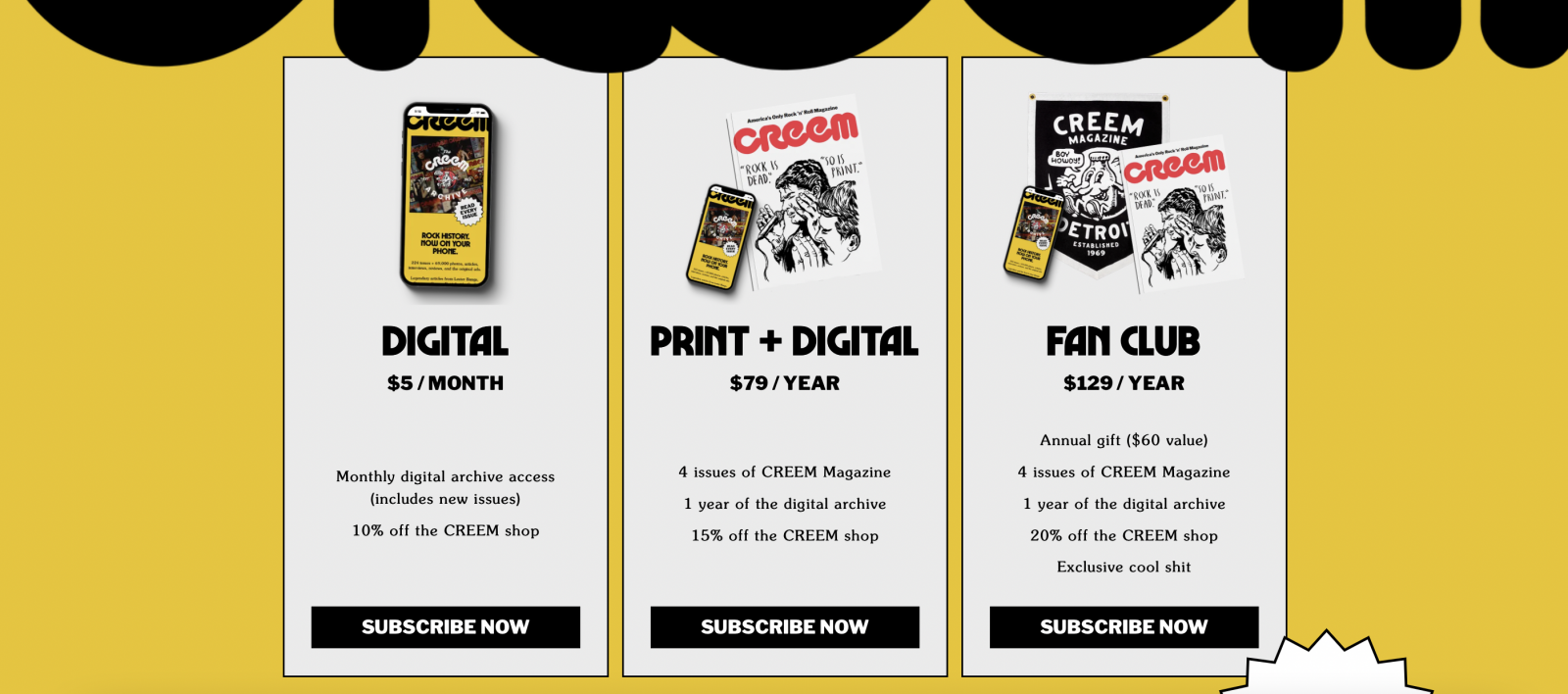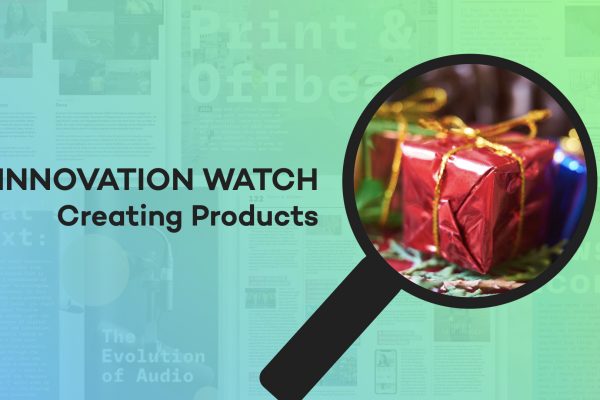Innovation Watch: Creating Products
In this, the fourth instalment of our Innovation Watch Series – based on the chapters of the 2022-23 Innovation in Media World Report – we take a look at the importance of creating products, especially in an increasingly reader-revenue orientated industry.
We know that product bundles can be just as popular in the magazine sector as they can for news, and recently looked at the relaunch of CREEM magazine. The US rock title has this month published its first print edition in 33yrs, which is being made available by way of a unique subscriptions offering.
For US$5 a month, subscribers can access over 69,000 archive articles, reviews, images, and ads, which have been meticulously scanned and presented in the form of the 224 original issues. Those wishing to upgrade their membership can opt for the print + digital option ($79/year), and there’s even a fan club priced at $129 per year that includes, in the words of the publisher, ‘exclusive cool shit’.

It’s a bundling approach spanning print and digital that we’ve seen similar examples of before, such as in the building out of Bauer’s Inside Empire club.
And in many ways, modern product marketing does not necessarily need to be about reinventing the wheel, but can simply mean switching focus to the creation of a vehicle – or vehicles – that consumers can get on-board with. Quality journalism is a valuable service, and the key to helping consumers understand – and embrace – that value as succinctly as possible, is through the creation of accessible products…
From revenues to readers, and back again
In the fourth chapter of the Innovation in Media World Report 2022-23, titled ‘How to Run a Product Team & Build a Data-Driven Newsroom’, Juan Senor and his team look at the work undertaken by modern product specialists, through the lens of a report published in 2021 by the International News Media Association’s (INMA) Product Initiative Lead, Jodie Hopperton:
‘One other thing Hopperton flags is that product development is not necessarily novel, or about creating shiny new things. The reality is that optimisation could sometimes be the key to better performance and for most product teams, 90% or more of the time is spent optimising the current product rather than developing brand new ones. Some examples of just how effective this optimisation process can be:
- The New York Times found that allowing users to login via clicking a link in an email (“magic linking”) had a 2% lift in successful logins.
- The Wall Street Journal was able to increase app downloads by 450% through using link texting for app downloads.
- The Telegraph saw when it optimised its homepage speed (going from 9 seconds to load to 5.5 seconds), it had a 12% increase in pageviews from subscribers.
In a second report published by INMA in February of this year, and also referenced in the Inno product chapter, Hopperton identifies 7 key steps to a successful media product process:
- The Mission: Nothing will come together without clearly articulated, easily understood, transparent goals and objectives.
- Articulate the problem: Know what issue your media organisation is trying to solve and why. The what, who, why, where, when, and how questions aren’t just for reporters. Creating a hypothesis statement, problem solving, and focusing on the outcome are key.
- Define customer needs: Growth occurs when customer needs are addressed consistently, creatively, and strategically. The user needs model is simple because it is external and comes from users.
- Validate the Data: This is the point where product teams test the hypothesis, as well as the steps before product design.
- Create a Prototype/MVP: This is the time to ask about functionality, desirability, usability, and engagement — and get input from all teams.
- Test & Iterate: The team has experimented, is confident in the product, and now it’s time to test. After the prototype/MVP has been tested with a subsection of readers, it is time to scale up, making your tests more and more broad.
- Share results: Product team jargon doesn’t always translate to other departments within the media company. Too much data can be a dangerous thing, so narrow it down to three to five things to share. Also, explain why teams in other departments should care.
Get stacked like a tech
We see this sort of process taking place all the time in the tech sector, and for a tangible example, one need look no further than the story we published this week on Zuora’s US$44m acquisition of Zephr:
‘First set up in 2018 by James Henderson and Chris Scott, Zephr launched as a subscription experience platform focused on accelerating revenue growth, with customers including News Corp, McClatchy, and Bauer. When the deal goes through (expected early September), it will join a host of other platforms already in Zuora’s product range, such as Zuora Billing, Zuora Revenue, and Zuora Collect.’

It’s an approach that I can remember seeing implemented with great success at comScore, during my time there in the late noughties. As the internet evolved, the range of data coming through the analytics company’s online panel grew accordingly, from search queries, to social rankings, video views, and so on.
But we knew that such a swelling sea of data, while extremely valuable, had the potential to overwhelm clients, especially those who may not necessarily be data specialists themselves. So a series of comprehensible products was created, which allowed us to bundle the data up into neat little packages: Media Metrix, Video Metrix, qSearch and so on.
Indeed, so structured did the product marketing process become, that the UK MD at the time began to refer to it as ‘making the doughnuts’. At the beginning of each month we would sit down, work out what headline data was coming through from each individual product, and use that to create releases to send out to specific press verticals, thusly maximising traction.
This well-oiled assembly line of doughnuts is what in a sense allowed us the time to develop further products, automating delivery to meet existing orders, while working at the back of the shop floor on new data, editorial, products, solutions, and so on.
Build a legacy, inside an empire
Today on FIPP.com (an outlet that was just this month listed as a Google News outlet I might add!) we are beginning to think more deliberately in these terms ourselves. From the Global Media Tech Regulation Tracker, to The Media Weekly and FIPP World Newsletter, and beyond to the segmentation of specific resource sections, we want to make our content as immediately useful and easily accessible as possible.
For the media industry at large, we are undoubtedly witnessing an interesting time in the evolution of product marketing. Magazines and newspapers were for many years the perfect product platform, for audiences and advertisers alike. The value exchange – at every corner – was palpable.

In the modern digital age, publishers still sit in prime position to take advantage of such neatly packaged offerings – because of both the premium content environments they offer, and the increasing shift towards first-party data strategies.
But again… if you want to read the full Innovation chapter on product marketing, then you’ll need to access the full publication, which you can find out more on here… a neatly packaged bit of comprehensive content if ever I’ve seen one!
Further reading
- The CREEM magazine and Inside Empire examples reference above can be viewed here and here, respectively.
- Our latest Media Unscripted podcast, which features Conde’s VP of New Business Innovation on the challenges – and opportunities – of Web3, is now available on general release, and can be found here.
- If you want an old skool insight into just how formulaically we were able to bundle vast swathes of data up into tangible products at comScore back in the day (at a time when Google Analytics was still finding its feet!) then one for you here.
- The recent confirmation of Disney+’s impending ad-supported platform, here.
- And remembering of course that content always remains key, some good work here from ELLE in updating its offering recently.









